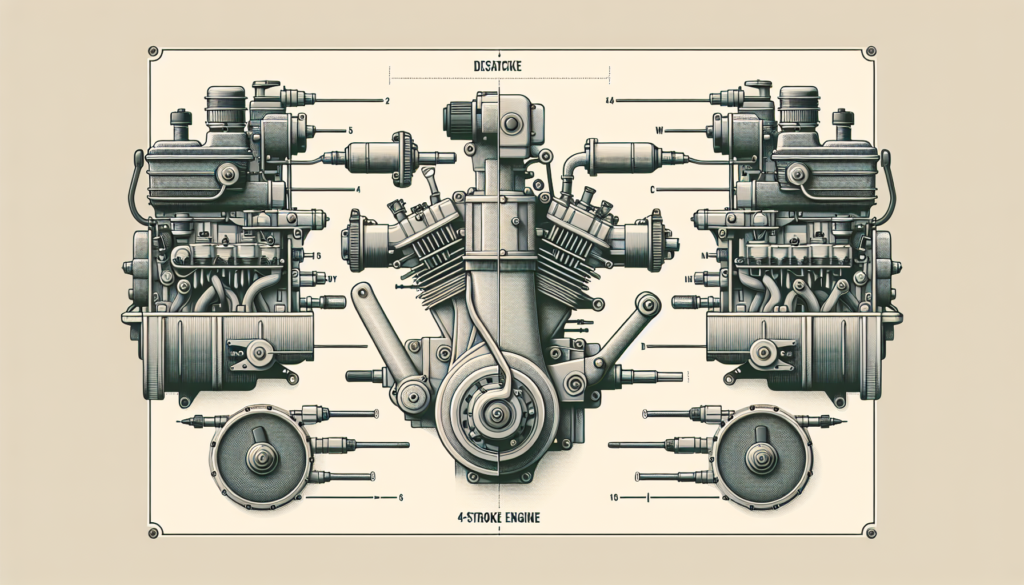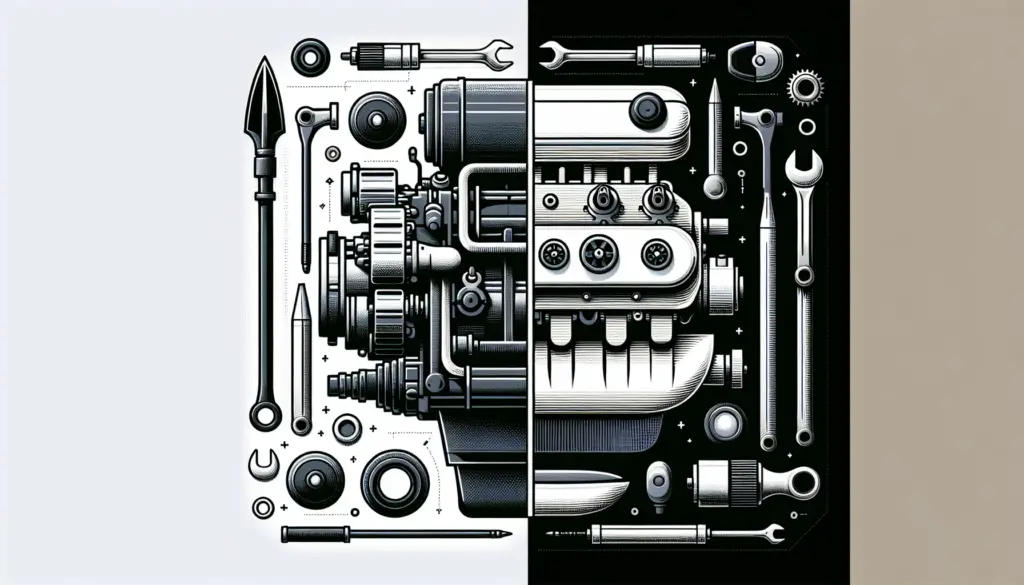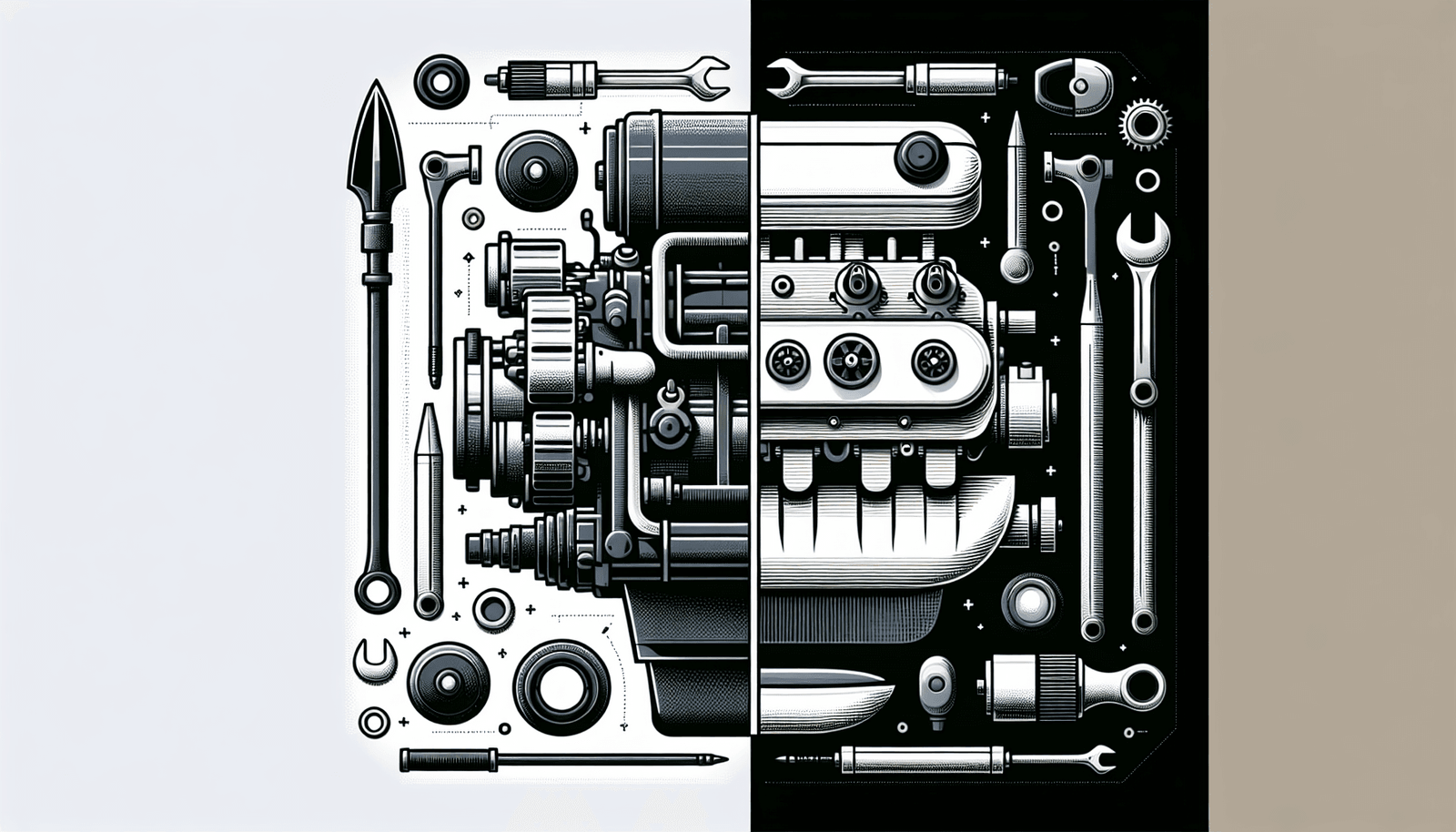Imagine you’re out on the water, the sun gleaming off your boat’s hull and the breeze in your face. But what’s powering your aquatic adventure? When it comes to the heart of your vessel, you’ve got two choices: a 2-stroke or a 4-stroke engine. In this article, you’ll explore the benefits and drawbacks of both options, making your decision a little simpler the next time you set sail. We’ll unpack all the technical jargon for you and break it all down in this comprehensive guide to 2-stroke versus 4-stroke boat engines.

Understanding the Basic Mechanisms
Before diving into the pros and cons of 2-stroke and 4-stroke engines, it helps to have a basic understanding of how these two types of engines work.
Definition of a 2-Stroke Engine
A 2-stroke engine is an internal combustion engine that completes the process of intake, compression, combustion and exhaust in just two strokes of the piston. This means that the engine fires, or ignites, once for every revolution of the crankshaft.
Operation Mechanism of a 2-Stroke Engine
When you pull the starter cord on a 2-stroke engine, the piston moves up, compressing the fuel-air mixture. When it reaches the top of the cylinder, the spark plug ignites the mixture, causing it to explode and push the piston back down. As the piston moves down, it first uncovers the exhaust port, allowing burnt gases to escape, and then it uncovers the intake port, pulling in fresh fuel and air. The whole cycle then repeats itself.
Definition of a 4-Stroke Engine
A 4-stroke engine, on the other hand, goes through the same four operations — intake, compression, combustion, and exhaust — but it does this in four strokes, or two complete revolutions of the crankshaft. This means the engine fires once for every two revolutions of the crankshaft.
Operation Mechanism of a 4-Stroke Engine
In a 4-stroke engine, the first stroke, or upward movement of the piston, pulls in fresh fuel and air (the intake stroke). The second stroke compresses this mixture (the compression stroke), and the spark plug ignites it at the top of the cylinder (the power or combustion stroke). The explosion drives the piston down, and then a second upward movement of the piston expels the burnt gases (the exhaust stroke).
Efficiency Considerations
Now that you know how both engines work, we can discuss their relative efficiency.
Fuel Efficiency in 2-Stroke Engines
2-stroke engines have traditionally been less fuel efficient than 4-stroke engines, partially because some of the fuel-air mixture can escape unburnt during the exhaust phase. Additionally, 2-stroke engines require an oil-fuel mixture, which can also reduce their fuel efficiency.
Fuel Efficiency in 4-Stroke Engines
In contrast, 4-stroke engines typically consume less fuel because the intake and exhaust operations are separated, so there’s less chance of unburnt fuel escaping. Moreover, 4-stroke engines use straight gasoline, which contributes to better fuel economy.
Comparing Consumption Rates
When it comes to consumption rates, it can seem like the 4-stroke has the clear advantage. However, due to the fact that 2-stroke engines produce power with every revolution as opposed to every second revolution in a 4-stroke, a 2-stroke engine can often be more powerful for a given size or weight.
Power to Weight Ratio
The power-to-weight ratio of an engine can have a significant impact on the performance of your boat.
Power to Weight in 2-Stroke Engines
2-stroke engines have the edge when it comes to power output relative to their weight. They’re lighter and smaller than a 4-stroke engine of equivalent power. This can be especially beneficial for lighter, smaller boats, where a heavier engine might upset the balance of the boat.
Power to Weight in 4-Stroke Engines
4-stroke engines are typically heavier than 2-stroke engines of the same power. They have more components and a more complicated design, which adds to their weight. The higher weight might be a disadvantage for smaller boats but mostly negligible for larger vessels.
Implications on Boat Performance
The power-to-weight ratio can impact the speed and maneuverability of your boat. For those who prioritize high performance and speed, a lighter yet powerful 2-stroke engine might be preferable. However, if steady cruising speed and smooth operation is your goal, a 4-stroke engine can perform admirably.
Maintenance and Durability
When it comes to engine longevity and maintenance requirements, there are important differences between the two types.
Longevity of 2-Stroke Engines
2-Stroke engines can have a shorter life expectancy compared to 4-stroke engines. This is due to the fact that they operate at higher temperatures and RPMs, which can cause more rapid wear and tear over time.
Maintenance Requirements for 2-Stroke Engines
Another significant difference is the maintenance requirements. 2-stroke engines require more maintenance because of the use of a gasoline-oil mixture, which necessitates regular oil changes and tune-ups. A failure to properly maintain a 2-stroke engine can lead to significant problems down the line.
Longevity of 4-Stroke Engines
On the flip side, 4-stroke engines tend to have a longer lifespan. They operate at slower speeds and lower temperatures, which generally correlates to a lower rate of wear and tear. With the right maintenance, you can expect a 4-stroke engine to outlast a 2-stroke.
Maintenance Requirements for 4-Stroke Engines
While 4-stroke engines do require routine oil changes, they typically need less frequent maintenance compared to 2-stroke engines. They run on pure gasoline, and the oil reservoir is separate. However, when they do require maintenance, it can be more cost-intensive given the complexity of their design.

Environmental Impact
With increasing awareness about environmental sustainability, it’s crucial to examine the emissions and environmental impact of these two engine types.
Emissions from 2-Stroke Engines
Traditionally, 2-stroke engines are associated with higher emissions. Due to the overlap in the exhaust and intake phases, some of the fuel can escape unburnt, which leads to increased pollution.
Emissions from 4-Stroke Engines
In contrast, 4-stroke engines burn fuel more cleanly, leading to lower emissions. Their separate intake and exhaust strokes ensure that nearly all the fuel is burnt and reduces the amount of unburnt fuel that’s emitted.
Comparing Pollution Levels
Between the two, 4-stroke engines are generally seen as more environmentally friendly due to their lower emissions. But keep in mind, modern advancements have made 2-stroke engines much cleaner than their older counterparts, and several models meet current emission standards.
Cost Considerations
Upfront costs and operational costs are key considerations when choosing an engine.
Initial Purchase Price of 2-Stroke Engines
2-Stroke engines usually cost less initially than 4-stroke engines. They have a simpler design and fewer parts, which makes them less expensive to manufacture and purchase.
Operational Costs for 2-Stroke Engines
However, the operational costs for a 2-stroke engine can be higher. They consume more fuel and oil than 4-stroke engines, and their need for frequent maintenance may also result in additional costs over the engine’s lifespan.
Initial Purchase Price of 4-Stroke Engines
On the other hand, a 4-stroke engine has a higher initial cost. Their complex design and the additional parts required can make these engines pricier to manufacture, resulting in a higher up-front purchase price.
Operational Costs for 4-Stroke Engines
While they consume less fuel and oil, 4-stroke engines may have higher operational costs in terms of maintenance. While maintenance is needed less frequently, it can be more complex and expensive when it is required.

Performance in Different Conditions
The performance of 2-stroke and 4-stroke engines can vary depending on the water conditions and speed requirements.
2-Stroke Engines in Various Water Conditions
2-Stroke engines are lightweight and powerful, which makes them great for speed and for handling tough water conditions. They’re quick to accelerate and responsive, allowing for good control in choppy water or when towing water skiers or wakeboarders.
4-Stroke Engines in Various Water Conditions
4-Stroke engines, while not as powerful, excel in cruising performance and stability. They’re great for a relaxed day on the lake or a long-distance boat trip. Their smoother, quieter operation also makes them a good choice for fishing or wildlife watching, where minimizing disturbance is important.
Comparing Engine Performance at High or Low Speeds
2-Stroke engines have a clear advantage at high speeds due to their higher power-to-weight ratio. However, at lower speeds, or while idling, 4-stroke engines deliver smoother and quieter operation.
Noise and Vibration Levels
Noise and vibrations from the engine can be a significant factor in the enjoyment of your boating experience.
Noise Generation from 2-Stroke Engines
2-Stroke engines tend to be louder and produce more vibrations, primarily due to their high revving nature. This might not be an issue for some, especially if you’re into high-speed boating or water sports. But for those who prefer a peaceful ride, this could be a downside.
Vibration Levels in 2-Stroke Engines
You can feel the raw power of a 2-stroke engine through the vibrations. However, these vibrations can also be fatiguing during long trips or when trying to maintain a steady speed while fishing.
Noise Generation from 4-Stroke Engines
On the flip side, 4-stroke engines are quieter and generate fewer vibrations. This could be a major plus if you’re into fishing, sailing, or simply want a quieter ride to enjoy a conversation or the surrounding scenery.
Vibration Levels in 4-Stroke Engines
Even in terms of vibration, 4-stroke engines have a smoother operation. They offer a relaxed and comfortable experience, which can be less fatiguing over the course of a long journey.
Starting and Operating Differences
How an engine starts and operates can also be a factor in your choice.
Ease of Starting 2-Stroke Engines
2-stroke engines are generally easier to start, which can be an important consideration, especially in emergency situations where you might need to get your engine started quickly.
Operating 2-Stroke Engines
Once they’re started, 2-stroke engines are pretty straightforward to operate. However, you’ll need to take care of the correct oil-gasoline mixture, as a wrong mix can cause serious damage.
Ease of Starting 4-Stroke Engines
4-stroke engines might pose more challenges when starting, especially in colder conditions. Because they usually have more components, there are simply more things that can go wrong.
Operating 4-Stroke Engines
The operation of a 4-stroke engine can be smoother and more predictable. You don’t have to worry about mixing oil and gasoline, which simplifies the refueling.
Choosing the Right Engine for your Boat
When it comes to choosing between a 2-stroke and a 4-stroke engine, there isn’t a one-size-fits-all answer. The best choice depends on your specific needs and circumstances.
Considering Boat Size and Purpose
The size and intended use of your boat are crucial factors. If you have a small boat and need high power for activities like racing or water sports, a 2-stroke engine could be the way to go. But if you have a larger boat and mostly use it for cruising or fishing, a 4-stroke engine can be a better option.
Choosing Based on Fuel Economy
If fuel economy is high on your list of priorities, a 4-stroke engine is typically more fuel-efficient. However, you should also consider that 2-stroke engines often provide more power for their weight, which can result in better performance.
Choosing Based on Maintenance Preferences
When it comes to maintenance, a 4-stroke engine might require less frequent servicing but might be more complicated and expensive when it does need maintenance. On the other hand, while a 2-stroke engine requires more frequent attention, the maintenance tasks are often simpler and cheaper.
Considering Environmental Impact
Considering environmental impact is important too. 4-stroke engines are considered more eco-friendly due to their lower emissions, but recent improvements in 2-stroke technology have significantly reduced their environmental impact.
Making the Final Decision
In the end, you’ll need to weigh all these factors and decide which engine is the best match for your boating needs and lifestyle. Whether you choose a 2-stroke or a 4-stroke, the most important thing is that the engine suits your needs and provides you with plenty of great times on the water.

